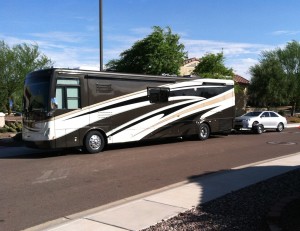 The biggest part of getting a motorhome ready for travel is the maintenance. The previous owners of our motorhome said they had done the required maintenance the year before but could not produce any documentation to that fact. We purchased the Extended Warranty package from the previous owners but were afraid the Warranty Company would decline the transfer because they had not done the required maintenance. Fortunately they did accept the transfer after we did the required maintenance plus fixing things that were really needed, like cracked hoses in the fuel line that could have led to a fire.
The biggest part of getting a motorhome ready for travel is the maintenance. The previous owners of our motorhome said they had done the required maintenance the year before but could not produce any documentation to that fact. We purchased the Extended Warranty package from the previous owners but were afraid the Warranty Company would decline the transfer because they had not done the required maintenance. Fortunately they did accept the transfer after we did the required maintenance plus fixing things that were really needed, like cracked hoses in the fuel line that could have led to a fire.
In addition, we spent every day for weeks from about 5am to 10am cleaning, fixing, more cleaning, and getting the coach ready to roll. Why 5am? Because it was 200 degrees during the day in early July in Phoenix! Caulking the roof with special sealer with the temp over 110 degrees would not be fun. It has rained so much on the trip we were glad we resealed the roof!
Tires. The biggest challenge turned out to be the Michelin tires. We were told by our maintenance company, Massey Diesel in Phoenix, and the local Michelin Truck Tire dealer, that we needed to change out the tires as the sidewalls were “cracking” from age. We learned RV tires, unlike semi-truck tires, don’t wear the tread out, rather ozone kills them over time. Trucks travel 100,000+ miles per year so the tires don’t last but a year or two. RV’s only travel about 5,000 to 15,000 per year so time kills an RV tire. You start checking for deterioration of the rubber at 5 years from the date on the sidewall, not the coach build date, and every year thereafter. Michelin says 10 years of life maximum, but say they should be changed after 7 years because of “checking” or sidewall cracking. Our tries had a date code in early 2007 so they were over 7 years old. They had plenty of tread left, but had sidewall checking. The Michelins have a softer ride because their sidewalls flex more than other tires. At the same time this flexing causes early deterioration of the sidewalls and they start “checking”.
We naïvely thought you just go to a Michelin Truck Tire dealer, plunk down your money, they mount the tires and off you go. Wrong. The coach came from the factory with Michelin Tires, 305/70R22.5, load range L for the weight they would carry. Seems Michelin, in their wisdom, haven’t made any in that size, or any other larger motorhome sizes, in many, many months. Every dealer I contacted, every chain plus independents in the USA, were out. Only Spartan and Freightliner had them for new chassis and they weren’t selling to the public. Sure dealers had one or two, here and there, but no sets. I was told they had been on back-order for several months, and it would be several months before they could get supply back into the pipeline. So in looking for alternatives, there was only one additional tire made in that size and load range, a Toyo from Japan. So we ordered these and had them installed in less than a week, thank you Phoenix Tire, instead of waiting another 2 months or more for Michelins. The Toyo’s were 60% of the price of the Michelins but do give a harsher ride, at least in the front where we have to run 125 psi due to the load. In the rear, we can run 90 psi based on the weight, for a softer ride out back. The psi is based on the weight carried, the load range of tire and the number of tires. I.e. 2 in the front carry up to 14,600 pounds (7,300 pounds each tire) and the 4 in the back carry 20,000 pounds (5,000 pounds per tire, so we can run lower pressures). If you own a motorhome, have it weighed front and rear fully loaded for travel with full fuel, either at a CAT certified scale at a truck stop, or all 4 corners at an RV rally, or at the Spartan Factory and adjust the tire pressure based on your tire load chart.